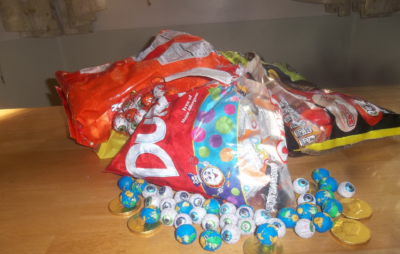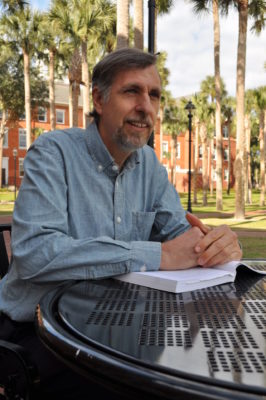Editor's Note
Paul Croce is Professor of History and American Studies, Stetson University, author of Young William James Thinking (Johns Hopkins University Press, December 2018), and the creator of The Public Classroom See essays on Halloweens Past, https://pubclassroom.com/category/cultural-life/sampling-popular-culture-at-megahalloween/.
In case you are wondering where kids get their ideas for Halloween costumes, I have a modest proposal. Consider the large sample in the small town of DeLand, Florida. With over two thousand children dressed up on Halloween night in my neighborhood, I invite friends and students to join in the fun with a purpose: where do kids get their ideas for being Themselves 2.0 for a night of Trick-or-Treating?
There is no baby boom in the neighborhood. Instead, people converge from every neighborhood and nearby towns. The result is a robust cross section of Americans, including large numbers of African Americans, Hispanics, and European Americans, with a diverse range of social classes represented. All these different people, with no debating, no competition, and no fighting. Everyone has the common purpose of having fun.
As Nicholas Rogers points out in Halloween: From Pagan Ritual to Party Night (2002), much of the fun is based on a cultural inversion of social norms, with a celebration of fear and death, even as these somber topics emerge in stylized forms, while the temporary free expression and violation of conventions, carnival style, adds reinforcement of those norms for every other day of the year. The playfulness is also an inversion of the holiday’s historical roots in scary and solemn traditions.

Halloween treats
To get ready for the carnival setting, I invested in over two thousand treats, including a few hundred store-bought candies, but also many Fair Trade chocolates and other treats, with labels offering messages about sustainable environmental practices, fair pricing, and decent working conditions for the otherwise invisible workers of our joyful fields of play; see https://www.fairtradecertified.org/. I also bought temporary tattoos, finger puppets, and pencils that say “MegaHalloween DeLand USA.” These are better for general health than sugary candies and dentist approved for the teeth, but I found no equivalent Fair Trade certifying for these mini-toys. All these preparations for the event provided lessons in the challenges of public history: striving to do the right thing is difficult to pull off on a mass scale, because when reaching more people, the messages can get muffled or ignored. I thought of William James’s counsel about the “legitimacy of … some” in that I reached some people with some messages about connecting their consumption to social justice issues (A Pluralistic Universe, 1909). If I had tried for more, I would have risked the Bob Dylan warning, becoming “my enemy in the instant that I preach” (“My Back Pages,” 1964).
To the curb then, with bowls of treats in hand, to meet the kids in outfits. Here was a chance to test out a large theoretical question. Do children get their ideas from mass-mediated culture or from folk culture and personal connections? The short answer is that the popular culture of movies, TV, and video games has captured the imaginations of large numbers of young people for their outfits, which included lots of Spidermen, Mutant Ninja Turtles and other Ninjas, Arendelle characters from Frozen (more Elsas than Annas), and a Wonder Woman-Captain America gender bender.
But folk culture ain’t dead in these children’s minds, and a lot of those outfits were funner, a word my own kids taught me, and yes, it is funner than its more grammatical cousins. There was a wide assortment of animals from tigers and wolves to spiders, lady bugs, bees, and lots of cats and butterflies. There were classics from folklore including Rapunzel and quite a few Cleopatras and unicorns, and many fruits and vegetables including strawberries, grapes, and even an eggplant. And behold, the Cavewoman who Invented Fire and even a Midwife—Laurel Thatcher Ulrich would be proud. And was this one providing a commentary on our culture and eating habits: “I’m a Chick-Fil-A Chicken Who Made a Run For It!”

Paul Croce
As with the subaltern citizens in Kathy Peiss’s Cheap Amusements (1986) and Lisabeth Cohen’s Making a New Deal(2/e, 2008), the kids really showed their own agency with the power of their imaginations in their creative combinations and playful variations on outfit ideas from both popular and folk culture. Who’s that girl in the red cape? It’s Little Old Riding Hood. New recruits needed for NASA? Snoopy Astronaut is ready. One boy was Behind the 8 Ball he was wearing; one girl was a Cheerless Leader. Mickey and Minnie Mouse made an appearance with their child, Mini Minnie. Another family featured Ghost Buster parents with a child as the Ghost and baby in carriage as the Stay Puff Marshmallow Man. One mother watching over a small posse of revelers spoke bluntly: ‘I’m Wife-Mom-Witch.” Another self-professed Witch had endorsement from her friend: “It’s not an outfit.”
Public impatience with contemporary politics showed up with not a single political figure in costume, but public respect for the military reported for duty with a Special Ops soldier, a Navy Seal, and an (already) Dead Army Person. Mr. Rogers was right about children being ready to talk about serious issues. Lots of Americans like their guns, and the kids did their part to support gun culture with a Hunter and Deer, which was still a live character, while another child dressed as a Dead Bear. A young father put a positive spin on his thinning hair: “I’m not balding; I’m sprouting.” My personal favorite was Jesus in Plain Clothes, which combined a touch of irreverence with a modern upgrade.
Our children, like the rest of the American populace, have a range of thoughts, some liberal and some conservative; some conform dutifully with mainstream views, while others are ready to think outside the box. Halloween is a chance for them to reach outside their daily lives and dress up in their imaginations. While the call of marketing and of ambition is to “be all that you can be,” this carnival night is a chance to be something more and different.
As with their adult peers, for some Trick-or-Treaters, this is simply an opportunity to tap some already well-stocked imaginations from the purveyors of mass culture—and to fill their own goodie bags. But for others, Halloween’s a chance to play with their identity, at least for one night. At a time when so many cultural and political positions remain entrenched, the path of imagination, appearing in full force at this night of spooks and scares, may provide a way to make an end run around the rigid disagreements. In that play of imagination may be the seeds for the next generation’s creativity and challenges to business as usual. Can Americans find paths out of our wickedly difficult challenges? Halloween night suggests we can, if we dare to live up to our imaginations.

0